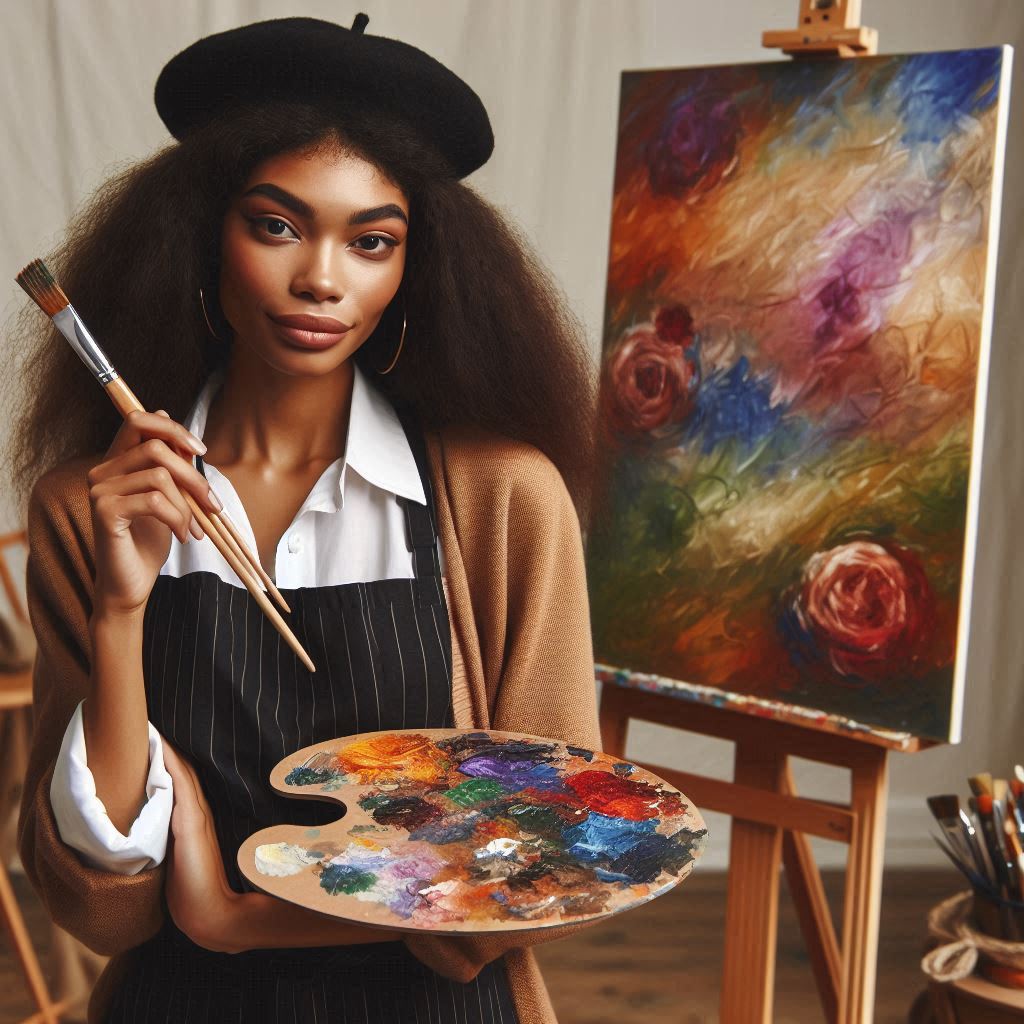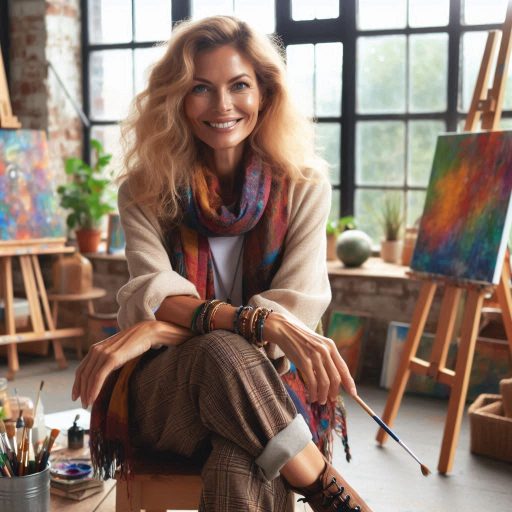Introduction
Art therapy is a unique and powerful therapeutic practice that combines principles of psychology with creative expression.
It utilizes various artistic processes, such as painting, drawing, and sculpting, to help individuals explore their emotions, thoughts, and experiences in a meaningful way.
Unlike traditional talk therapy, art therapy encourages clients to express themselves through creative activities, allowing for non-verbal communication that can be particularly beneficial for those who find it challenging to articulate their feelings.
This therapeutic approach promotes self-discovery, emotional healing, and personal growth by enabling individuals to visualize their thoughts and emotions in a tangible form.
The role of an art therapist is multifaceted and requires a blend of artistic skill and psychological knowledge.
Art therapists are trained professionals who hold degrees in both art and psychology, equipping them with the tools to facilitate artistic experiences within a therapeutic framework.
They begin by assessing each client’s unique needs and goals, developing individualized treatment plans that encourage self-exploration and creative expression.
By guiding clients through various artistic activities, art therapists create a safe and supportive environment where individuals can express complex emotions, work through trauma, and develop essential coping strategies.
Morning Routine
Wake Up Early to Prepare for the Day
Art therapists often start their day early.
Waking up before sunrise helps them mentally prepare for the busy day ahead.
After a refreshing shower, they focus on setting a positive tone for the day.
Review Schedule and Client Appointments
Once they’re dressed, art therapists check their schedules.
They review client appointments to understand what lies ahead.
Each session is unique, and therapists aim to tailor their approach to each client’s needs.
They note any specific materials required for the sessions.
This preparation allows them to create a welcoming environment for their clients.
Eat Breakfast and Mentally Prepare for the Day Ahead
Eating breakfast is an essential part of the morning routine.
A balanced meal fuels them for the day’s challenges.
Many art therapists prefer nutritious options like fruits, whole grains, or smoothies.
These choices provide the energy needed to stay focused during sessions.
Breakfast is also a time for reflection.
They mentally go over their clients’ backgrounds and previous sessions.
This helps them plan effective art activities that promote healing and self-expression.
Mental preparation is vital for art therapists.
They often engage in mindfulness practices to center themselves.
Some may practice deep breathing or meditate for a few minutes.
This helps clear their minds and enhances their emotional awareness.
A calm and focused therapist creates a safe space for clients.
This sets the stage for open and honest communication during therapy sessions.
During this quiet time, art therapists also review their therapeutic goals.
They remind themselves of the importance of their role.
Each client’s progress is meaningful, and they take pride in facilitating that journey.
This motivation fuels their passion for art therapy.
As they finish breakfast, they may gather their art supplies.
Collecting materials like paints, clay, and drawing tools ensures they have everything needed for the day.
They often organize their workspace, making it inviting and inspiring for clients.
A well-organized environment fosters creativity and comfort during sessions.
Before leaving for work, art therapists often take a moment for gratitude.
They reflect on their purpose and the impact they have on their clients’ lives.
This practice reinforces their commitment to helping others heal through art.
With everything prepared, they head out the door.
Their morning routine sets a positive tone for the day.
Read: Character Design Trends: What’s Hot in 2024?
Client Sessions
Meet with Clients Throughout the Day for Individual and Group Art Therapy Sessions
Art therapists spend their day meeting clients for individual and group sessions.
Each session offers a unique opportunity for healing and growth.
They work with various age groups, from children to adults.
Individual sessions allow for personalized attention, while group sessions encourage shared experiences.
The diversity of clients enriches their practice and enhances their understanding of different perspectives.
Create a Safe and Comfortable Environment for Clients to Express Themselves Through Art
Creating a safe and comfortable environment is crucial for effective art therapy.
Therapists carefully design their spaces to promote openness and creativity.
They use soft lighting, calming colors, and comfortable seating to make clients feel at ease.
A welcoming atmosphere encourages clients to express themselves freely.
The therapist’s warm demeanor helps clients feel secure and supported.
This foundation fosters trust and allows for deeper exploration of emotions.
Provide Guidance and Support as Clients Explore Their Emotions and Thoughts
During sessions, art therapists provide guidance and support as clients explore their emotions.
They encourage clients to use various art materials to express their feelings.
This can include painting, drawing, or sculpting, depending on the client’s preference.
As clients engage in creative activities, therapists facilitate conversations about their art.
They ask open-ended questions to help clients reflect on their experiences and feelings.
Therapists actively listen, offering insights and affirmations to validate clients’ emotions.
This supportive approach helps clients gain insights into their struggles and triumphs.
Through art, clients can communicate thoughts that may be difficult to express verbally.
The creative process becomes a powerful tool for self-discovery.
In group sessions, art therapists guide discussions and activities that encourage interaction among participants.
They create opportunities for clients to share their work and experiences.
This fosters a sense of community and belonging.
Participants often find comfort in knowing they are not alone in their challenges.
As the sessions progress, therapists adapt their techniques based on clients’ responses.
They remain attuned to the emotional needs of each individual.
This flexibility allows for a tailored approach that maximizes therapeutic benefits.
The art therapist’s role is to empower clients, helping them find their voice through creativity.
At the end of each session, therapists reflect on the progress made.
They encourage clients to continue their artistic exploration outside of therapy.
This ongoing practice supports emotional growth and healing between sessions.
Through this process, art therapists play a vital role in guiding clients on their journeys toward self-acceptance and emotional well-being.
Read: How to Price Your Ceramic Artwork
Art Therapy Techniques
Use Various Art Materials and Techniques Such as Painting, Drawing, and Sculpting
Art therapists utilize various art materials and techniques in their practice.
They encourage clients to experiment with mediums like painting, drawing, and sculpting.
Each medium provides a unique way to express thoughts and emotions.
For instance, painting allows for vibrant expressions, while drawing offers precision and detail.
Sculpting encourages tactile engagement, fostering a deeper connection with the creative process.
By introducing diverse materials, therapists help clients discover their preferred methods of expression.
Encourage Clients to Explore Their Creativity and Express Themselves Authentically
Encouraging clients to explore their creativity is a fundamental aspect of art therapy.
Therapists create an environment where clients feel free to express themselves authentically.
They emphasize that there are no right or wrong ways to create art.
This freedom nurtures self-exploration and discovery.
Clients often surprise themselves with their creative capabilities, gaining confidence in their artistic voice.
By letting go of self-judgment, they can tap into their true emotions and thoughts.
Therapists may introduce guided exercises to spark creativity.
For example, they might suggest spontaneous drawing or using colors to represent feelings.
These activities allow clients to delve into their emotions and uncover hidden aspects of themselves.
The act of creating becomes a journey of self-discovery, promoting personal growth and insight.
Help Clients Process and Understand Their Feelings Through the Art-Making Process
The art-making process serves as a powerful tool for clients to process and understand their feelings.
As clients create, they often find it easier to articulate their emotions.
Therapists facilitate discussions about the artwork, asking open-ended questions.
This helps clients reflect on what their creations represent.
For instance, they might explore why they chose certain colors or shapes.
By discussing their art, clients gain insights into their emotional states.
They learn to identify and articulate feelings they may have struggled to express verbally.
This understanding fosters emotional awareness, which is essential for healing.
Moreover, the act of creating art can be cathartic.
It allows clients to release pent-up emotions in a constructive manner.
For many, art becomes a safe outlet for anxiety, grief, or frustration.
Through this process, they learn to cope with and manage their feelings more effectively.
Art therapists also guide clients in recognizing patterns in their artwork over time.
This ongoing reflection can reveal shifts in emotions and perspectives.
As clients progress, they may notice growth in their coping skills and self-awareness.
In summary, art therapy techniques play a crucial role in facilitating healing and self-exploration.
By using diverse materials, encouraging authenticity, and processing emotions through art, therapists empower clients on their journeys.
This creative process fosters personal insight, resilience, and emotional well-being.
Read: Top Skills Needed for a Successful Character Designer

Documentation and Evaluation
Take Notes During Client Sessions to Track Progress and Insights
Documentation is a critical aspect of an art therapist’s role.
During client sessions, therapists take detailed notes to track progress and insights.
These notes capture clients’ emotional states, artistic choices, and any significant breakthroughs.
By recording observations, therapists can identify patterns and changes over time.
This documentation helps build a comprehensive understanding of each client’s journey.
Therapists may note specific techniques that resonate with clients or shifts in their artistic expression.
This information provides valuable context for future sessions, allowing for a more personalized approach.
Keeping thorough records also ensures continuity of care.
When clients return for subsequent sessions, therapists can refer to past notes, maintaining a connection to their ongoing experiences.
Evaluate Client Artwork to Understand Underlying Emotions and Themes
Evaluating client artwork is another vital part of the documentation process.
Therapists analyze the artistic expressions to uncover underlying emotions and themes.
Each piece of art can reveal insights about the client’s feelings, thoughts, and experiences.
For example, the choice of colors, shapes, and composition can reflect a client’s mood and state of mind.
Therapists encourage clients to discuss their artwork, asking open-ended questions about their creations.
This dialogue fosters a deeper understanding of the emotions behind the art.
By exploring these themes, therapists help clients gain awareness of their inner struggles and triumphs.
Art evaluation also allows therapists to recognize progress.
Changes in a client’s artwork over time can indicate growth, healing, or shifts in perspective.
By comparing earlier pieces with more recent creations, therapists can track the evolution of emotions and coping mechanisms.
Treatment Plans and Goals with Clients Based on Their Artwork
Based on the insights gained from client artwork, therapists discuss treatment plans and goals collaboratively.
They involve clients in the planning process, ensuring that treatment aligns with their needs and desires.
This collaborative approach empowers clients, giving them a sense of ownership over their therapeutic journey.
Therapists may set specific goals related to emotional expression, coping skills, or self-awareness.
By discussing these objectives, clients can understand the purpose behind their sessions.
This clarity fosters motivation and engagement in the therapeutic process.
Regular evaluations of treatment plans are essential.
Therapists may adjust goals based on clients’ progress, ensuring that they remain relevant and achievable.
This adaptability is crucial in art therapy, where emotional states can change rapidly.
Documentation and evaluation are key components of effective art therapy.
By taking notes during sessions, evaluating client artwork, and discussing treatment plans, therapists create a supportive framework for growth.
This process enhances clients’ understanding of their emotions and fosters meaningful progress on their therapeutic journeys.
Read: Career Paths in Ceramic Art and Design
Collaborative Work
Consult with Other Healthcare Professionals Such as Psychologists and Social Workers
Collaboration is a cornerstone of effective art therapy.
Art therapists frequently consult with other healthcare professionals, such as psychologists and social workers.
These collaborations enhance the overall quality of care for clients.
By sharing insights and expertise, therapists can develop a more comprehensive understanding of each client’s needs.
Consulting with psychologists provides valuable context regarding a client’s mental health history.
It enables art therapists to tailor their approaches effectively.
Collaborating with social workers can help address external factors impacting a client’s well-being.
This teamwork fosters a holistic approach to treatment, ensuring all aspects of a client’s life are considered.
Coordinate Care Plans with Clients’ Primary Therapists or Healthcare Providers
Art therapists also coordinate care plans with clients’ primary therapists or healthcare providers.
This coordination ensures that therapeutic goals align across disciplines.
By communicating regularly, therapists can share updates on client progress and any emerging challenges.
Establishing clear lines of communication is vital for effective coordination.
Therapists may use shared documentation systems or regular check-ins to keep all parties informed.
This collaborative effort ensures a unified approach to treatment, enhancing the overall effectiveness of therapy.
Clients benefit from a cohesive care plan that addresses their emotional and psychological needs.
Attend Team Meetings to Discuss Client Progress and Adjust Treatment Plans as Needed
Team meetings play a crucial role in collaborative work.
Art therapists attend these meetings to discuss client progress and adjust treatment plans as needed.
These meetings often include various healthcare professionals involved in the client’s care.
Sharing insights during these discussions can lead to innovative approaches and strategies for clients.
During meetings, therapists present observations from their sessions and share insights gained from evaluating artwork.
This information can help inform treatment adjustments.
If a client shows signs of emotional distress or stagnation, the team can brainstorm new interventions or support strategies.
Regular team meetings foster a collaborative environment where professionals can learn from one another.
This ongoing dialogue enhances the therapeutic process, allowing for real-time adjustments to care plans.
Collaborative work is essential for successful art therapy.
By consulting with other healthcare professionals, coordinating care plans, and attending team meetings, art therapists ensure comprehensive support for their clients.
This teamwork enhances the effectiveness of treatment, promoting holistic healing and growth.
Through collaboration, clients receive well-rounded care that addresses their diverse needs and fosters positive outcomes.
Transform Your Career Today
Unlock a personalized career strategy that drives real results. Get tailored advice and a roadmap designed just for you.
Start NowSelf-Care and Professional Development
Practice Self-Care Techniques to Prevent Burnout and Maintain Emotional Well-Being
Self-care is essential for art therapists to maintain their emotional well-being.
Practicing self-care techniques helps prevent burnout in this demanding profession.
Therapists often face intense emotional challenges while supporting clients.
To sustain their ability to help others, they must prioritize their own health.
Therapists may engage in various self-care activities.
These can include mindfulness exercises, physical fitness, and hobbies unrelated to work.
Setting aside time for personal interests fosters balance and rejuvenation.
Additionally, maintaining a healthy work-life balance is crucial for emotional resilience.
Regularly disconnecting from work allows therapists to recharge and return to their practice with renewed energy.
Attend Workshops, Conferences, and Trainings to Expand Knowledge and Skills in Art Therapy
Continuing education is vital for art therapists to stay current in their field.
Attending workshops, conferences, and training sessions expands their knowledge and skills.
These professional development opportunities provide insights into new techniques and therapeutic approaches.
Therapists benefit from networking with peers and experts during these events.
They can share experiences, gain different perspectives, and learn about best practices.
Workshops often cover a range of topics, from advanced art techniques to innovative therapeutic models.
This ongoing learning ensures that therapists remain effective in their practice.
Engage in Supervision and Peer Support to Reflect on Client Cases and Seek Guidance from Experienced Therapists
Supervision and peer support are critical components of professional development.
Engaging in regular supervision allows therapists to reflect on client cases.
Experienced supervisors provide valuable guidance and feedback, helping therapists navigate complex situations.
Peer support groups offer a safe space for therapists to share their experiences.
Discussing challenging cases with colleagues fosters collaboration and learning.
These interactions can lead to new strategies and approaches that enhance therapeutic practice.
Participating in supervision and peer support also combats isolation.
Therapists often work independently, and connecting with others helps create a sense of community.
Sharing successes and challenges can reinforce the importance of self-care and professional growth.
In summary, self-care and professional development are crucial for art therapists.
Practicing self-care techniques prevents burnout, allowing therapists to maintain emotional well-being.
Continuing education through workshops and conferences enhances their skills and knowledge.
Engaging in supervision and peer support fosters reflection and growth.
Together, these practices ensure that art therapists remain effective, resilient, and passionate about their work.
Administrative Tasks
Schedule Client Appointments and Manage Paperwork
Administrative tasks are an essential part of an art therapist’s role.
Scheduling client appointments efficiently ensures a smooth workflow.
Therapists must keep track of their availability while accommodating clients’ needs.
They often use digital calendars and scheduling software to manage appointments effectively.
In addition to scheduling, therapists manage various types of paperwork.
This includes intake forms, consent documents, and treatment plans.
Keeping accurate records is vital for maintaining a professional practice.
Proper documentation helps track client progress and comply with legal requirements.
Therapists must also update client files regularly.
This includes recording notes from sessions and documenting any changes in treatment plans.
Staying organized minimizes confusion and enhances the therapeutic process for both clients and therapists.
Communicate with Insurance Companies and Billing Departments
Effective communication with insurance companies and billing departments is crucial for art therapists.
Therapists must understand insurance policies to help clients navigate coverage for therapy sessions.
This may involve verifying benefits, obtaining authorizations, and submitting claims.
Clear communication helps prevent misunderstandings and ensures clients receive the financial support they need.
Therapists must stay informed about billing practices and changes in insurance policies.
This knowledge enables them to provide accurate information to clients and avoid potential issues.
Managing billing processes efficiently is also essential.
Therapists must track payments, send invoices, and follow up on outstanding balances.
Maintaining organized financial records is critical for sustaining a successful practice.
Maintain Confidentiality and Ethical Standards in All Aspects of Practice
Maintaining confidentiality and ethical standards is paramount in art therapy.
Therapists must protect clients’ privacy and sensitive information at all times.
This commitment builds trust and creates a safe space for clients to express themselves.
Art therapists adhere to professional codes of ethics, which guide their practice.
These standards ensure that therapists conduct themselves responsibly and with integrity.
They must continually educate themselves about ethical practices to stay compliant with regulations.
Confidentiality extends to all aspects of the practice, including administrative tasks.
Therapists must handle paperwork securely and limit access to sensitive information.
By prioritizing confidentiality, they foster a respectful and professional environment for clients.
Administrative tasks are vital for effective art therapy practice.
Scheduling appointments and managing paperwork ensure a smooth workflow.
Communicating with insurance companies and billing departments helps clients navigate financial matters.
Most importantly, maintaining confidentiality and ethical standards builds trust and safeguards clients’ well-being.
These administrative responsibilities allow art therapists to focus on what they do best—supporting clients through the transformative power of art.
Conclusion
Art therapists play a vital role in helping clients explore their emotions and thoughts through creative expression.
By utilizing various artistic mediums, they create a safe space for individuals to process feelings, fostering self-discovery and healing.
Art therapy allows clients to communicate in ways words often cannot express, leading to profound insights and personal growth.
In this demanding profession, self-care is crucial.
Art therapists must prioritize their well-being to effectively support clients through challenging emotional experiences.
Engaging in regular self-care practices helps therapists maintain resilience and emotional balance, ultimately benefiting their clients.
Additionally, ongoing professional development is essential for success in the field.
Art therapists should seek training and workshops to stay updated on new techniques and best practices, ensuring they provide the highest quality care.
For those with a passion for art and psychology, pursuing a career in art therapy offers a rewarding opportunity.
This profession allows you to make a meaningful difference in others’ lives while combining creativity with compassion.
If you feel drawn to help others navigate their emotions through art, consider exploring a career in art therapy.
It can lead to a fulfilling path that not only enriches your life but also transforms the lives of those you support.
Embrace the chance to foster healing and growth in your community through the power of artistic expression.
[E-Books for Sale]
The Big Book of 500 High-Paying Jobs in America: Unlock Your Earning Potential
$19.99 • 500 High-Paying Jobs • 330 pages
Explore 500 high-paying jobs in America and learn how to boost your career, earn more, and achieve success!
See All 500 High-Paying Jobs of this E-Book
1001 Professions Without a Degree: High-Paying American Jobs You Can Start Now
$19.99 • 1001 Professions Without a Degree • 174 pages
Discover 1001 high-paying jobs without a degree! Unlock career tips, skills, and success strategies for just $19.99!




